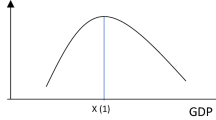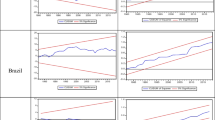Abstract
The accelerated urbanization process generates a significant increase in energy, whose sources are mainly polluting. The harmful effects of both processes are reflected in climate change. This article examines the equilibrium and causality relationship among urban concentration, non-renewable energy consumption, and the real per capita output in 110 countries during 1971–2017. Using data from the World Bank’s World Development Indicators (2018), we classify countries into four groups according to their level of development. Our evidence suggests that urban concentration has a negative effect on real per capita output in high-income countries, while non-renewable energy consumption has a positive effect on all groups of countries. The cointegration tests show that there is short- and long-term equilibrium in all groups of countries. The results of the DOLS and PDOLS models indicate that the strength of the cointegration vector is weak in most of the countries and groups analyzed. The Granger-type causality tests show that there is bidirectional causality from the real per capita output to the urban concentration in high and middle-low-income countries. There is unidirectional causality from the population concentration towards the real per capita output in the low-income countries; from the non-renewable energy consumption to the real per capita output in high-income countries; from the real per capita output to the non-renewable energy consumption in the countries of medium-high and medium-low income; and from urban concentration to non-renewable energy consumption in high- and medium-high-income countries. Our results highlight the importance of promoting policies of urban planning and generation and consumption of renewable energy without limiting the expansion of the output.
Similar content being viewed by others
References
Adams S, Klobodu E, Apio A (2018) Renewable and non-renewable energy, regime type and economic growth. Renew Energy 125:755–767
Alvarado R, Toledo E (2017) Environmental degradation and economic growth: evidence for a developing country. Environ Dev Sustain 19(4):1205–1218
Alvarado R, Correa-Quezada R, Tituaña-Castillo M (2017a) Internal migration and urbanization without efficiency in developing countries: evidence for Ecuador. Pap Poblac 23(94):99–123
Alvarado R, Iñiguez M, Ponce P (2017b) Foreign direct investment and economic growth in Latin America. Econ Anal Policy 56:176–187
Alvarado R, Ponce P, Criollo A, Córdova K, Khan MK (2018) Environmental degradation and real per capita output: new evidence at the global level grouping countries by income levels. J Clean Prod 189:13–20
Arvin M, Pradhan R, Norman N (2015) Transportation intensity, urbanization, economic growth, and CO2 emissions in the G-20 countries. Util Policy 35:50–66
Alvarado R, Ponce P, Alvarado R, Ponce K, Huachizaca V, Toledo E (2019) Sustainable and non-sustainable energy and output in Latin America: A cointegration and causality approach with panel data. Energy Strategy Reviews, 26, 100369.
Asuad, N. (2001). Economía regional y urbana. Introducción a las teorías, técnicas y metodologías básicas. Benemérita Universidad Autónoma de Puebla, México.
Atienza M, Aroca P (2013) Concentration and growth in Latin American countries. In: regional problems and policies in Latin America. Springer, Berlin, pp 113–133
Bakirtas T, Akpolat A (2018) The relationship between energy consumption, urbanization, and economic growth in new emerging-market countries. Energy 147:110–121
Balchin, P. N., Bull, G. H., & Kieve, J. L. (1995). Urban land economics and public policy. Macmillan International Higher Education.
Baum, C. F., & Christopher, F. (2006). An introduction to modern econometrics using Stata. Stata press.
Belke A, Dobnik F, Dreger C (2011) Energy consumption and economic growth: new insights into the cointegration relationship. Energy Econ 33(5):782–789
Breitung J (2000) Nonparametric tests for unit roots and cointegration. J Econ 108(2):343–363
Brückner M (2012) Economic growth, size of the agricultural sector, and urbanization in Africa. J Urban Econ 71(1):26–36
Brülhart M, Sbergami F (2009) Agglomeration and growth: cross-country evidence. J Urban Econ 65(1):48–63
Bucci A (2008) Population growth in a model of economic growth with human capital accumulation and horizontal R&D. J Macroecon 30(3):1124–1147
Chen S, Kuo H, Chen C (2007) The relationship between GDP and electricity consumption in 10 Asian countries. Energy Policy 35(4):2611–2621
Chiou-Wei, S., Chen, C., & Zhu, Z. (2008). Economic growth and energy consumption revisited
Choi I (2001) Unit root tests for panel data. J Int Money Financ 20:249–272
Christaller W (1966) Central places in southern Germany. Prentice Hall
Dumitrescu E, Hurlin C (2012) Testing for granger non-causality in heterogeneous panels. Econ Model 29(4):1450–1460
Easterly W, Levine R (1997) Africa's growth tragedy: policies and ethnic divisions. Q J Econ 112(4):1203–1250
Eggoh J, Bangake C, Rault C (2011) Energy consumption and economic growth revisited in African countries. Energy Policy 39:7408–7421
Fay M, Opal C (2000) Urbanization without growth: a not so uncommon phenomenon, vol 2412. World Bank Publications, Washington D.C
Firebaugh, G. (1979). Structural determinants of urbanization in Asia and Latin America, 1950-1970. American Sociological Review, 199-215.
Frick S, Rodríguez-Pose A (2018) Change in urban concentration and economic growth (No. 1803). Utrecht University, Department of Human Geography and Spatial Planning, Group Economic Geography
Fujita M, Thisse J (2003) Does geographical agglomeration foster economic growth? And who gains and loses from it? Jpn Econ Rev 54(2):121–145
Fujita M, Krugman P, Venables A (2001) The spatial economy: cities, regions, and international trade. MIT Press
Glaeser E, Kallal H, Scheinkman, & Shleifer, A. (1992) Growth in cities. J Polit Econ 100(6):1126–1152
Glaeser E, Henderson V (2017) Urban economics for the developing world: an introduction. J Urban Econ 98:1–5
Gozgor G, Lau C, Lu Z (2018) Energy consumption and economic growth: new evidence from the OECD countries. Energy 153:27–34
Gylfason T (2001) Natural resources, education, and economic development. Eur Econ Rev 45(4–6):847–859
Hadri K (2000) Testing for stationarity in heterogeneous panel data. Econ J 3:148–161
Halicioglu F, Ketenci N (2018) Output, renewable and non-renewable energy production, and international trade: evidence from EU-15 countries. Energy 159:995–1002
Hausman, J. A. (1978). Specification tests in econometrics. Econometrica, 1251-1271.
Henderson V, Wang H (2007) Urbanization and city growth: the role of institutions. Reg Sci Urban Econ 37(3):283–313
Henderson V (2000) The effects of urban concentration on economic growth (No. w7503). National bureau of economic research
Henderson V (2003) The urbanization process and economic growth: the so-what question. J Econ Growth 8(1):47–71
Henderson V (2005) Urbanization and growth. Handb Econ Growth 1:1543–1591
Henderson V (2010) Cities and development. J Reg Sci 50(1):515–540
Hwang J (2006) Introduction of new goods, convergence and growth, vol 15. Department of Economics, Harvard University
Jedwab R, Vollrath D (2015) Urbanization without growth in historical perspective. Explor Econ Hist 58:1–21
Jedwab R, Christiaensen L, Gindelsky M (2015) Demography, urbanization and development: rural push, urban pull and urban push? The World Bank, Washington, D. C Working Paper
Kanjilal K, Ghosh S (2013) Environmental Kuznets’s curve for India: evidence from tests for cointegration with unknown structural breaks. Energy Policy 56:509–515
Lee C (2005) Energy consumption and GDP in developing countries: a cointegrated panel analysis. Energy Econ 27(3):415–427
Levin A, Lin C, Chu C (2002) Unit root tests in panel data: asymptotic and finite-sample properties. J Econ 108(1):1–24
Liu Y (2009) Exploring the relationship between urbanization and energy consumption in China using ARDL (autoregressive distributed lag) and FDM (factor decomposition model). Energy 34(11):1846–1854
Lucas R (1988) On the mechanics of economic development. J Monet Econ 22(1):3–42
Martin P, Ottaviano G (2001) Growth and agglomeration. Int Econ Rev 42(4):947–968
Matsuyama K (1992) Agricultural productivity, Comparative Advantage and Economic Growth. J Econ Theory 58(2):317–334
Mehrara M (2007) Energy consumption and economic growth: the case of oil exporting countries. Energy Policy 35(5):2939–2945
Moomaw R (1981) Productivity and city size: a critique of the evidence. Q J Econ 96(4):675–688
Nasreen S, Anwar S (2014) Causal relationship between trade openness, economic growth and energy consumption: a panel data analysis of Asian countries. Energy Policy 69:82–91
Noor S, Siddiqi M (2010) Energy consumption and economic growth in South Asian countries: a co-integrated panel analysis. Int J Human Soc Sci 5(14):921–926
Ortiz C, Alvarado R, Salinas A (2019) The effect of military spending on output: new evidence at the global and country group levels using panel data cointegration techniques. Econ Anal Policy 62:402–414
Ozturk I (2010) A literature survey on energy–growth nexus. Energy Policy 38(1):340–349
Ozturk I, Aslan A, Kalyoncu H (2010) Energy consumption and economic growth relationship: evidence from panel data for low and middle income countries. Energy Policy 38(8):4422–4428
Pedroni P (1999) Critical values for cointegration tests in heterogeneous panels with multiple regressors. Oxf Bull Econ Stat 61(S1):653–670
Pedroni P (2001) Purchasing power parity tests in cointegrated panels. Rev Econ Stat 83(4):727–731
Prebisch R (1962) The economic development of Latin America and its principal problems. Econ Bull Latin Am 1:1–22
Razzaqi, S., Bilquees, F., & Sherbaz, S. (2011). Dynamic relationship between energy and economic growth: evidence from D8 countries. The Pakistan Development Review, 437-458.
Romer P (1989) Human capital and growth: theory and evidence (No. w3173). National Bureau of economic research
Rosenthal S, Strange W (2004) Evidence on the nature and sources of agglomeration economies. In: Handbook of Regional and Urban Economics, vol 4, pp 2119–2171
Saboori B, Sulaiman J (2013) CO2 emissions, energy consumption and economic growth in association of southeast Asian nations (ASEAN) countries: A cointegration approach. Energy 55:813–822
Sachs J, Warner A (2001) The curse of natural resources. Eur Econ Rev 45(4–6):827–838
Salim R, Shafiei S (2014) Urbanization and renewable and non-renewable energy consumption in OECD countries: an empirical analysis. Econ Model 38:581–591
Salim R, Hassan K, Shafiei S (2014) Renewable and non-renewable energy consumption and economic activities: further evidence from OECD countries. Energy Econ 44:350–360
Singer H (1950) The distribution of gains between investing and borrowing countries. Am Econ Rev 40(2):473–485
Sinha A, Sengupta T, Alvarado R (2019) Interplay between technological innovation and environmental quality: formulating the SDG policies for next 11 economies. J Clean Prod 242(1):118549 In Press
United Nations (2014) World urbanization prospects, the 2011 revision. Population Division, Department of Economic and Social Affairs, Washington D.C
Westerlund J (2007) Testing for error correction in panel data. Oxf Bull Econ Stat 69(6):709–748
Williamson J (1965) Regional inequality and the process of national development: a description of the patterns. Econ Dev Cult Chang 13(4, part 2):1–84
Wooldridge J (1991) On the application of robust, regression-based diagnostics to models of conditional means and conditional variances. J Econ 47(1):5–46
Wooldridge J (2002) Econometric analysis of cross section and panel data. MIT Press, Cambridge
World Bank (2009). Informe sobre el desarrollo mundial 2009. Una nueva geografía económica. Washington DC, disponible en http://siteresources.worldbank.org/INTWDR2009/Resources/WDR_OVERVIEW_ES_Web.pdf (visitado por última vez el 22/2/2010)
World Bank (2018). World Development Indicators, Washington D.C.
World Bank. (2018). Atlas Method GNI per capita, Washington D.C.
Yang Y, Liu J, Zhang Y (2017) An analysis of the implications of China’s urbanization policy for economic growth and energy consumption. J Clean Prod 161:1251–1262
Yao X, Zhou H, Zhang A, Li A (2015) Regional energy efficiency, carbon emission performance and technology gaps in China: A meta-frontier non-radial directional distance function analysis. Energy Policy 84:142–154
Young A (1991) Learning by doing and the dynamic effects of international trade. Q J Econ 106(2):369–405
Zafar MW, Shahbaz M, Hou F, Sinha A (2019) From nonrenewable to renewable energy and its impact on economic growth: the role of research & development expenditures in Asia-Pacific economic cooperation countries. J Clean Prod 212:1166–1178
Zhang Z, Zhang A, Wang D, Li A, Song H (2017) How to improve the performance of carbon tax in China? J Clean Prod 142:2060–2072
Zhao Y, Wang S (2015) The relationship between urbanization, economic growth and energy consumption in China: an econometric perspective analysis. Sustainability 7(5):5609–5627
Acknowledgments
The authors express their gratitude to the Club de Investigación de Economía (CIE), Loja Ecuador.
Author information
Authors and Affiliations
Corresponding author
Additional information
Responsible editor: Muhammad Shahbaz
Publisher’s note
Springer Nature remains neutral with regard to jurisdictional claims in published maps and institutional affiliations.
Rights and permissions
About this article
Cite this article
Alvarado, R., Ortiz, C., Bravo, D. et al. Urban concentration, non-renewable energy consumption, and output: do levels of economic development matter?. Environ Sci Pollut Res 27, 2760–2772 (2020). https://doi.org/10.1007/s11356-019-07158-8
Received:
Accepted:
Published:
Issue Date:
DOI: https://doi.org/10.1007/s11356-019-07158-8




